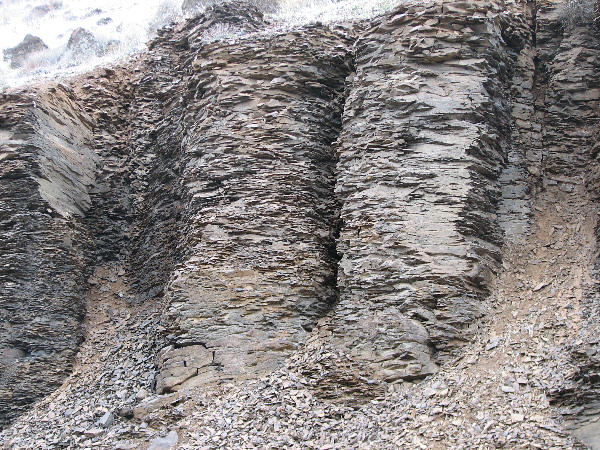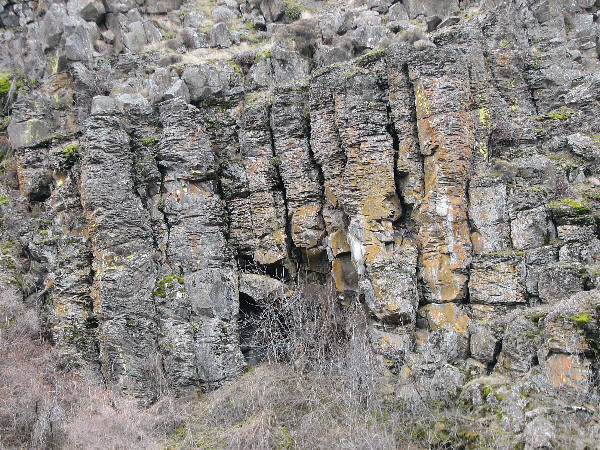Cowiche Canyon Conservancy
Mission: to promote a healthy future for our community by
conserving our heritage of open space, scenic vistas, and riparian
corridors from Yakima to the Cascade foothills, with connected
recreation trails and natural landscapes.
The word Cowiche, sometimes spelled Cowychee, is said to mean
footbridge between the valley and the mountains.
 There are two kinds of rocks at Cowiche Canyon: Columba Basalt and
Tieton Andesite. Only the Columbia Basalt is found at Snow Mtn
Ranch. Columbia Basalt is known as flood basalt because when it
erupts it is very runny (like pancake batter). Between 17 and 13
million years ago huge amounts of it repeatedly poured out of
fissures in the earth in the area where Washington, Oregon, and
Idaho come together. To give you an idea of how much basalt
erupted, over time it covered 200,000 square miles and at Cowiche
Canyon, which lies at the western edge of the Columbia Basin, the
basalt is 6,000 feet deep.
There are two kinds of rocks at Cowiche Canyon: Columba Basalt and
Tieton Andesite. Only the Columbia Basalt is found at Snow Mtn
Ranch. Columbia Basalt is known as flood basalt because when it
erupts it is very runny (like pancake batter). Between 17 and 13
million years ago huge amounts of it repeatedly poured out of
fissures in the earth in the area where Washington, Oregon, and
Idaho come together. To give you an idea of how much basalt
erupted, over time it covered 200,000 square miles and at Cowiche
Canyon, which lies at the western edge of the Columbia Basin, the
basalt is 6,000 feet deep.
 Columbia Basalt is considered world class because basalt seldom
erupts on a continent--- it usually comes out under the ocean.
Sometime after the basalt flows ended, pressures from the movement
of the Pacific and North American crustal plates against each other
folded the western portion of the Yakima Basin into a series of
east - west ridges called the Yakima Fold Belt by geologists. The
Cowiche Canyon uplands and Cowiche Mountain are part of the fold
known as Yakima Ridge.
Columbia Basalt is considered world class because basalt seldom
erupts on a continent--- it usually comes out under the ocean.
Sometime after the basalt flows ended, pressures from the movement
of the Pacific and North American crustal plates against each other
folded the western portion of the Yakima Basin into a series of
east - west ridges called the Yakima Fold Belt by geologists. The
Cowiche Canyon uplands and Cowiche Mountain are part of the fold
known as Yakima Ridge.
Finally, a million years ago what we now know as the Goat Rocks
west of Yakima was actually a large volcano like Mt. Rainier. A
little less than a million years ago a lava rock called Andesite
erupted from the Goat Rocks and flowed down the Tieton and Naches
Rivers to what we now call Painted Rocks. Geologists call this rock
the Tieton Andesite. At almost 50 miles long, the Tieton Andesite
is the longest andesite flow in the entire world.
Native Plants and Wildflowers
Native plants of this region are made up of four vegetation
layers: shrubs, perennial grasses, wildflowers, and a thin biotic
crust composed of lichens and mosses. They have adapted to the
extreme conditions of Central Washington where there is little
rain, strong winds, summer heat, and cold winters.
Common Shrubs: (just a few)
Big Sagebrush, Bitterbrush, Desert Buckwheat, Rabbitbrush, Stiff
Sagebrush.
Grasses:
Bluebunch Wheatgrass, Bulbous Bluegrass, and Cusick's
Bluegrass.
Wildflowers:
These tend to be very colorful and start to bloom in March as the
soil warms. A rare and threatened wildflower is the Hoover's
Tauschia due to loss of habitat. A few examples of what you will
see at the CCC: Bitterroot, Canby's Desert Parsley, Cusick's
Sunflower, Foothills Onion, Purple Sage, Sagebrush Buttercup,
Yellow Bell, and Sagebrush Violet.
Wildlife: just to name a few of what you may see or hear:
Red-Tailed Hawk, Turkey Vulture, Great Horned Owl, Mourning Dove,
Quail, Ring- neck Pheasant, Hummingbirds, Yellow- Bellied Marmot,
Cougars, Beaver, and of course the ever popular Western
Rattlesnake.
So, as you can see thanks to the Lava flows of millions of years
ago this great place, Cowiche Canyon, was formed. This area is for
public use with a few rules, such as no motorized vehicles, no
horses or mountain bikes when the ground is wet, such as when the
winter snow melts (early spring), stay on the paths so as not to
disturb the natural and sometimes endangered habitats. Cache-in,
Trash-out should always be practiced here. Don’t let pets or
kids wonder too far ahead for obvious reasons and dogs must be kept
on leash. The CCC is funded by donations and volunteers so as
cachers we need to do our best to keep the area as clean as
possible. I am on the volunteer list so when the CCC has a clean-up
day set-up I may put on another CITO event. I hope this was as
informational and educational for you as it was for me to research
this area and go and see firsthand what this awesome place is all
about, so come and enjoy.
congrats to Twowackywhits on the FTF.